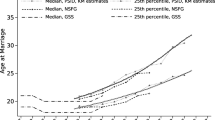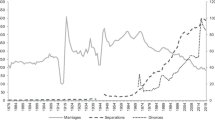Abstract
We use a 20 percent longitudinal sample of Canadian personal income tax returns to explore patterns and changes in marital status, with a focus on cohort behaviour. We define five different cohorts, each with a different starting age in 1995, and follow each over a 20-year data period. We consider and compare the changes in cohort patterns, giving special attention to the stability of married and common law unions, and for that purpose distinguishing unions with the same partner from those with a different one. Comparisons of cohort patterns show a shift toward an increased proportion reporting themselves as single or living in a common law union and a decreased proportion reporting married. The proportion married to the same partner declines, and the proportion married to a new partner increases, implying some reduction in marriage stability. Common law unions, more common at younger ages, appear unstable, but much of the apparent instability is removed when common law unions that would transition to married unions with the same partner are taken into account; common law as a premarital first stage appears to be increasingly common. At older ages the death of a partner is the major terminating factor at the end of a marriage, most prominently among males: widowhood (death of a partner) accounts for a much larger fraction of marriage terminations for women, death a much larger fraction for men, reflecting differences in life expectancy and the younger age at marriage of women, on average.
Résumé
Nous utilisons un échantillon longitudinal de 20 % de déclarations de revenus pour explorer les tendances et les changements dans l’état matrimonial, en mettant l’accent sur le comportement des cohortes. Nous définissons cinq cohortes différentes, chacune avec un âge différent en 1995, et nous utilisons une période de suivi de 20 ans. Nous examinons et comportement des cohortes. Nous définissons cinq cohortes différentes, chacune avec un âge différent en 1995, et nous utilisons une période de suivi de 20 ans. Nous examinons et le même partenaire de celles avec un autre partenaire. Les comparaisons entre les cohortes montrent une évolution vers une proportion accrue se déclarant célibataires ou vivant en union libre et une proportion réduite se déclarant mariés. La proportion de personnes mariées au même partenaire diminue et la proportion de personnes mariées à un nouveau partenaire augmente, ce qui implique une certaine réduction de la stabilité du mariage. Les unions libres, plus fréquentes à des âges plus jeunes, semblent instables, mais une grande partie de l’instabilité apparente disparaît lorsque l’on tient compte des unions de fait qui se transformeraient en unions mariées avec le même partenaire; l’union libre en tant que première étape prénuptiale semble donc être de plus en plus courante. Aux âges plus avancés, le décès d’un partenaire est le principal facteur de rupture à la fin d'un mariage, surtout chez les hommes : le veuvage représente une fraction beaucoup plus élevée pour les hommes, reflétant les différences d’espérance de vie et le jeune âge au mariage des femmes en moyenne.
Similar content being viewed by others
Availability of Data and Materials
The data are available in Statistics Canada Research Data Centres and accessible to those with approved projects. See https://crdcn.org/research to make application.
Code Availability
In the Supplementary Material, we provide the syntax code developed for the analysis to other researchers who wish to replicate our results.
Notes
Among the Canadian studies concerned with various aspects of marital stability based solely on cross-sectional data, we note Penning and Wu (2019) and Schimmele and Wu (2016), both of which draw on the Statistics Canada 2007 General Social Survey, Wright (2019) which draws on the 2011 GSS, and Margolis and Choi (2020), which draws on successive censuses. For a more extensive review of studies relating to marital stability, see Denton et al. (2020).
They explore a number of other aspects as well, including remarriage, and provide extensive references to the earlier literature.
We note that the CRA definitions of these categories differ somewhat from those used in other major demographic sources, such as censuses and surveys.
References
Becker, G. S. (1973). A theory of marriage: Part I. Journal of Political Economy, 81(4), 813–846. https://doi.org/10.1086/260084
Becker, G. S. (1974). A theory of marriage. In T. W. Schultz (ed.) Economics of the Family: Marriage, Children, and Human Capital, University of Chicago Press, 299–351.
Becker, G. S., Landes, E. M., & Michael, R. T. (1977). An economic analysis of marital instability. Journal of Political Economy, 85(6), 1141–1187. https://doi.org/10.1086/260631
Canada (2019). Federal income tax and benefit guide 2019, https://www.canada.ca/content/dam/cra-arc/formspubs/pub/5000-g/5000-g-19e.pdf, accessed April 21, 2020.
Denton, F. T., Spencer, B. G., Yip, T. A. (2020). Changes and stability in marital status: evidence from Canadian income tax returns. McMaster University, Department of Economics Working Paper Number 2020–07.
Eliason, M. (2012). Lost jobs, broken marriages. Journal of Population Economics, 25(4), 1365–1397. https://doi.org/10.1007/s00148-011-0394-4
Frimmel, W., Halla, M., & Winter-Ebmer, R. (2013). Assortative mating and divorce: Evidence from Austrian register data. Journal of the Royal Statistical Society: Series A (statistics in Society), 176(4), 907–929.
Margolis, R., & Choi, Y. (2020). The growing and shifting divorced population in Canada. Canadian Studies in Population, 47, 43–72.
Margolis, R., Choi, Y., Hou, F., & Haan, M. (2019). Capturing trends in Canadian divorce in an era without vital statistics. Demographic Research, 41(52), 1453–1478. https://doi.org/10.4054/DemRes.2019.41.52
Milan, A. (2013). Marital Status: Overview: 2011. Report on the demographic situation in Canada, Statistics Canada Catalogue no. 91–209-X, issue 2013001.
Penning, M. J. & Wu, Z. (2019) Caregiving and union instability in middle and later life, Journal of Marriage and Family, 81, (1). https://doi.org/10.1111/jomf.12534
Schimmele, C. M., & Wu, Z. (2016). Repartnering after union dissolution in later life. Journal of Marriage and Family, 78(4), 1013–1031. https://doi.org/10.1111/jomf.12315
Statistics Canada. (2016). Census of population, Statistics Canada Catalogue no. 98–400-X2016031.
Statistics Canada. (2018). Longitudinal administrative data dictionary 2015, Statistics Canada Catalogue no. 12–585-X, ISSN 1702–9449.
Svarer, M., & Verner, M. (2008). Do children stabilize relationships in Denmark? Journal of Population Economics, 21(2), 395–417. https://doi.org/10.1007/s00148-006-0084-9
Wright, L. (2019). Union transitions and fertility within first premarital cohabitations in Canada: Diverging patterns by education? Demography, 56, 151–167.
Acknowledgements
The calculations presented in this article were conducted at the McMaster Research Data Centre (RDC), which is part of the Canadian Research Data Centre Network (CRDCN). The services and activities provided by the McMaster RDC are made possible by the financial or in-kind support of the Social Sciences and Humanities Research Council, the Canadian Institutes of Health Research, the Canadian Foundation for Innovation, Statistics Canada, and McMaster University. The authors are grateful for helpful comments from the reviewers.
Author information
Authors and Affiliations
Corresponding author
Ethics declarations
Ethics Approval
Not relevant.
Consent to Participate
Not relevant
Consent for Publication
Not relevant
Conflict of Interest
The authors declare no competing interests.
Additional information
Publisher's Note
Springer Nature remains neutral with regard to jurisdictional claims in published maps and institutional affiliations.
Supplementary Information
Below is the link to the electronic supplementary material.
ESM 1
(PDF 153 KB)
Rights and permissions
About this article
Cite this article
Denton, F.T., Spencer, B.G. & Yip, T.A. Changes and Stability in Marital Status: Evidence from Canadian Income Tax Returns. Can. Stud. Popul. 48, 239–264 (2021). https://doi.org/10.1007/s42650-021-00048-w
Received:
Accepted:
Published:
Issue Date:
DOI: https://doi.org/10.1007/s42650-021-00048-w




